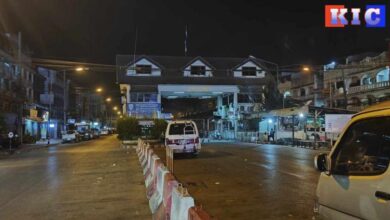A Hard Rain Falls

Heavy rains battering eastern Burma have destroyed many rice farms cultivated by displaced Karen people. Humanitarian groups on the Thai Burma border say these people will face a food crisis at the next harvest.
Naw Iris, a coordinator with the Committee of Internally Displaced Karen People (CIDKP) overseeing the Pa-an and Doo Pla Ya Districts spoke to Karen News about the potential crisis.
“In Pa-an district alone, there are 925 rice farms that the farmers cannot prepare for planting their rice crop because of the early rains.”
Naw Iris explained that the displaced villagers mainly rely on slash and burn farming.
“The people clear the forest at the beginning of January and burn it in late January and early February. This year the weather at this time was not as usual. Heavy rains started while villagers were still clearing the land for planting.”
Naw Iris estimated as many as 5,437 villagers will be affected by unseasonal rains in Pa-an, Lu Pleh township, Ta Nay Cha township and Hta Kreh township.
Naw Iris said the early rain will also hit villagers in Doo Pla Ya district as well and added that getting data to show how many villages will be effected is proving difficult.
Naw Iris predicted emergency relief maybe needed from CIDKP offices at the next harvest expected in October.
“If villagers don’t have enough food to feed their families many of them will seek work in Thailand.”
Karen News reporters traveled to a villagers hiding site in Southern Burma, Tenasserim division and talked to displaced villagers about the problem.
Saw Aye Pay, is a villager who has been hiding from the Burma army for 14 years and says he has lived by cultivating small rice fields and plantations out-of-sight of patrolling soldiers.
“This year we face a bigger problem, we won’t have enough food. It will be hard for the children. I have my children and wife to care for.”
Saw Ay Pay, has a wife and her five children to take car off.
Saw Ay Pay pointed to the hill where he usually grows his rice and explained that he was unable to burn the tall grass and undergrowth in preparation for planting.
Saw Say Moo another of the displaced villager’s said.
“I think only one third of the people who are hiding here will have enough food. Some are worried about how they can find food for their families. We don’t have money to buy food, even if we have money, it’s very difficult to go and buy food, we have to make contact with other villagers in Burma army forced relocation sites.”
Saw Ay Pay said Burma army patrols were a constant source of great stress for the villagers.
“We have to creep around like a thief avoiding Burmese soldiers. We have to sneak at night, walking in rivers, we cannot use torchlight and we risk falling. We are afraid the Burma army if they catch us will torture us, or they will shot to kill us.”
Saw Steve the secretary of CIDKP told Karen News that their staff based in southern Burma were still trying to get reliable estimates of the extent of the hardship caused by the unseasonal rains.
Saw Steve said every year displaced villagers faced severe food shortages due to the lack of reliable fertile land to grow their rice and crops.
“Each year there’s less available land to grow rice. More people are being forced out of their villages into concentrated smaller areas and because of the army patrols are constantly moving from place to place.”
Saw Steve said displaced villagers facing food shortages in Northern Karen State had difficulty getting to Thailand for assistance.
They have to rely on finding wild yams and other jungle vegetable and fruits. They also risk their lives when out foraging or hunting from landmines and Burma army patrols.”
CIDKP estimate that at least 8,885 villagers in 118 villages in Lu Thaw Township, Papun District (Mutraw) have either exhausted their current food supplies or are expecting to do so prior to the October 2011 harvest.
The over-population of ‘safe hiding areas’ has created shortages of arable land, depleted soil fertility and reduced potential crop yields. These existing obstacles to food security were compounded by an unusually dry rainy season in 2010, coupled with other environmental factors, causing the 2010 harvest to fail.
The Thailand Burma Border Consortium estimates there are as many as 446,000 displaced villagers in hiding in eastern Burma.




